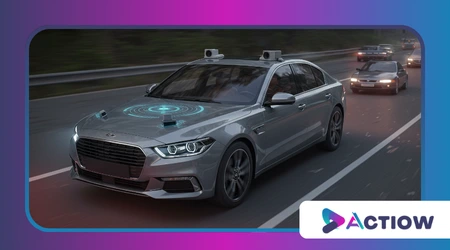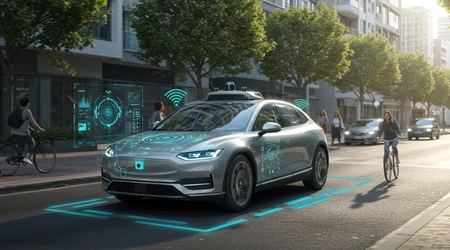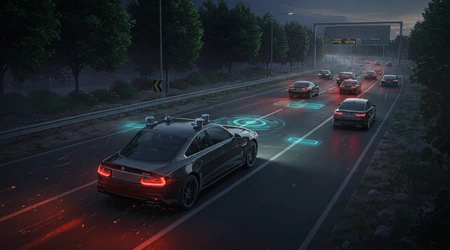Level 5 Autonomous Driving Technology: When Will It Hit the Market?

Anúncios
Level 5 Autonomous Driving Technology promises exactly that fully self-driving vehicles capable of navigating any road, anytime, anywhere, without human input.
Imagine a world where cars whisk you away effortlessly, no steering wheel needed, just pure, hands-free freedom.
It’s the holy grail of automotive innovation, a dream that’s tantalized engineers, futurists, and commuters alike for decades.
Anúncios
But as we sit here in 2025, sipping coffee and watching partial automation creep into our daily drives, the question looms large: when will this ultimate leap arrive?
The journey to full autonomy isn’t just about tech it’s tangled in regulations, safety debates, and human trust, all colliding in a fascinating dance of progress.
This isn’t some sci-fi fantasy anymore, it’s a tangible goal with real stakes.
Companies like Waymo, Tesla, and Baidu are pouring billions into cracking the code, racing against time and each other.
Yet, the finish line keeps shifting optimistic timelines from the early 2010s have melted into cautious forecasts, and for good reason.
The complexity of mimicking human intuition in unpredictable environments, from blizzards to bustling city streets, remains a colossal hurdle.
So, let’s dive deep into this automotive odyssey, exploring the tech, the roadblocks, and the tantalizing “when” that keeps us all guessing.
The Dream of Full Autonomy: What It Really Means
Picture yourself in a car that doesn’t just assist but takes total control, no pedals, no wheel, just you and your thoughts.
That’s the essence of Level 5 Autonomous Driving Technology complete independence from human oversight, a vehicle that masters every driving scenario imaginable.
Unlike Level 2 systems, like Tesla’s Full Self-Driving (FSD), which still demand constant attention, or Level 3, where drivers must jump in during emergencies, Level 5 needs no backup, it’s the pinnacle of the SAE’s automation scale.
++ Cars with Digital Keys: How They Work and Are They Secure?
Achieving this means blending cutting-edge AI, sensors like LiDAR and radar, and real-time data processing into a seamless symphony of decision-making.
It’s not just about avoiding obstacles, it’s about anticipating jaywalkers, deciphering faded road signs, and adapting to chaos like a sudden detour in a construction zone.
The appeal is undeniable: safer roads, less traffic, and time reclaimed for work or relaxation, but the leap from today’s tech to this vision is staggering, requiring breakthroughs we’re only beginning to grasp.

The Tech Powering the Revolution
At the heart of Level 5 Autonomous Driving Technology lies a cocktail of innovation AI algorithms humming, sensors scanning, and 5G networks pulsing with data.
Cameras capture every angle, LiDAR maps the world in 3D, and radar pierces through fog, all feeding into neural networks that mimic human reasoning, only faster and tireder-free.
Take Waymo’s fleet, for instance they’ve logged over 20 million real-world miles by 2025, refining their “Waymo Driver” into a near-flawless navigator, yet still confined to controlled zones.
But it’s not just hardware, software’s the real wizard here, crunching terabytes of data to predict a cyclist’s next move or a storm’s impact.
Also read: Cars with Artificial Intelligence: What to Expect in the Future?
Companies like NVIDIA are pushing the envelope with platforms like DRIVE Hyperion, powering cars with AI brains that learn on the fly.
Still, the tech’s not perfect urban jungles with their honking chaos and rural backroads with spotty connectivity test its limits, showing that full autonomy demands more than just fancy gadgets, it craves perfection.
The integration of 5G is a game-changer, enabling vehicle-to-everything (V2X) communication that lets cars chat with traffic lights, other vehicles, and even pedestrians’ phones.
This connectivity slashes reaction times and boosts safety, but it’s not widespread yet rural gaps and cybersecurity risks loom large.
Meanwhile, battery-powered electric vehicles (EVs) like Tesla’s Cybercab are prime candidates for autonomy, their sleek designs hiding complex systems that hum quietly toward a driverless future, if only the software can catch up.
Read more: Electric Cars 2025: Discover the Models That Will Dominate the Roads
Where We Stand in 2025
Fast forward to April 2025, and the automotive landscape’s buzzing with promise, yet full autonomy feels like a mirage.
Waymo’s robotaxis roam Phoenix and San Francisco, offering Level 4 rides impressive, but still tied to specific zones, not the anywhere-anytime dream of Level 5.
Tesla’s FSD, despite Elon Musk’s bold claims, hovers at Level 2+, facing scrutiny from the NHTSA over crashes, while Mercedes-Benz rolls out Level 3 in its 7 Series, letting drivers relax on highways, but not ditch the wheel entirely.
Baidu’s Apollo Go in China scales up, with 500 robotaxis in Wuhan aiming for 1,000 by year-end, a testament to government-backed ambition, yet it’s still Level 4.
McKinsey’s 2023 survey pegged Level 4 highway pilots by 2025 in North America and Europe, and we’re there, sort of but Level 5 Autonomous Driving Technology?
Experts whisper 2035, maybe 2040, as the tech stumbles over edge cases, like a deer darting across a foggy road, revealing how far we’ve yet to climb.
Progress isn’t uniform China’s racing ahead with state support, while the U.S. grapples with fragmented regulations, and Europe balances innovation with strict safety rules.
Consumer trust wavers too; a 2023 S&P Global survey showed Americans lag behind Chinese drivers in embracing autonomy, wary of glitches and cyberattacks.
So, here we are, teetering on the edge of a breakthrough, with dazzling demos but no universal key to unlock the final level.
Roadblocks on the Path to Level 5
Let’s talk hurdles, because the road to Level 5 Autonomous Driving Technology is littered with them technical, legal, and human, all snarling traffic.
Start with the tech: AI can ace highways, but throw in a monsoon or a kid chasing a ball, and it falters, unable to match human gut instinct.
Sensors get pricier in harsh conditions, and rural areas lack the 5G backbone to keep cars chatting, exposing a digital divide that’s tough to bridge.
Regulations are a mess California’s 2023 veto of driverless truck rules shows the tug-of-war between progress and caution, while Europe’s EU mandates lag behind tech leaps.
Safety’s the biggie: one glitch, like Cruise’s 2023 pedestrian incident, and trust craters, regulators pounce, and timelines stretch.
Then there’s us humans who love control, doubt machines, and fear job losses in trucking or taxis, slowing adoption even if the tech’s ready.
Cost’s another beast outfitting a car for Level 5 could top $100,000 today, per IDTechEx, though falling sensor prices hint at relief.
Cybersecurity looms too; a hacked fleet could grind cities to a halt, and insurers balk at uncharted liability waters.
Each snag be it a software bug or a lawmaker’s pen pushes the dream further out, a reminder that tech alone doesn’t dictate the pace, society does.
The Timeline Debate: Predictions and Pitfalls
So, when will Level 5 Autonomous Driving Technology hit the market 2030, 2040, or beyond?
Optimists point to Moore’s Law tech doubles every two years, so why not soon?
Waymo’s CEO hinted at “decades” in 2024, while Tesla’s Musk bets on 2027 for his Cybercab, though his track record’s spotty.
S&P Global’s 2023 forecast is sober: Level 5 won’t crack retail fleets by 2035, citing slow tech maturity and regulatory quicksand.
History backs the skeptics self-driving hype peaked in 2015, promising 2020, yet here we are, still tweaking Level 3.
Goldman Sachs predicts Level 3 at 10% of sales by 2030, Level 4 at 2.5%, but Level 5? A whisper in the wind.
It’s not just about solving edge cases, it’s syncing with lawmakers, insurers, and a public that’s half-thrilled, half-terrified, making every bold prediction a gamble with long odds.
The wildcard’s AI breakthroughs in neural networks could slash years off, like OpenAI’s leaps in natural language, applied to driving.
But pitfalls abound: a single high-profile crash, a cyberattack, or a recession could stall funding, as seen with Cruise’s 2024 cuts.
Look at China Baidu’s Apollo thrives on state cash, hinting that policy, not just tech, might decide the winner, leaving the timeline a thrilling, frustrating question mark.
Real-World Impacts: What Happens When It Arrives?
Imagine Level 5 Autonomous Driving Technology rolling out cities morph, commutes vanish, and economies flip upside down, it’s seismic.
Traffic deaths, 94% human-error driven per NHTSA, could plummet, saving lives and billions, while gridlock eases as cars glide in sync, cutting fuel waste.
Urban sprawl might surge, folks living farther out, working en route, but shared fleets could shrink car ownership, freeing up parking lots for parks.
Jobs shift truckers and cabbies face upheaval, yet coders and fleet managers rise, a double-edged sword of progress.
Insurance pivots from drivers to manufacturers, a $25 billion robotaxi market blooms by 2030, says Goldman Sachs, and EVs dominate, slashing emissions.
But sprawl could spike VKT (vehicle kilometers traveled), offsetting green gains, and rural areas lag, stuck in a tech twilight, showing autonomy’s ripple effects are as messy as they are massive.
Privacy takes a hit cars tracking every move, feeding data to Big Tech, spark debates over surveillance versus convenience.
Accessibility soars, elderly and disabled gain mobility, but affordability’s key: if Level 5 stays luxury-priced, it’s a privilege, not a right.
Picture a retiree in Miami zipping to the doctor, or a teen in Mumbai hailing a shared pod utopian, sure, but only if costs and infrastructure align, a puzzle still unsolved.

The Players in the Race
Who’s leading this charge toward Level 5 Autonomous Driving Technology?
Waymo’s a frontrunner, its 2,000+ robotaxis racking up miles, backed by Alphabet’s deep pockets and Google’s data trove.
Tesla’s in hot pursuit, betting on vision-only systems and its Dojo supercomputer, though FSD’s Level 2 label irks purists.
Baidu’s Apollo Go leverages China’s regulatory sandbox, scaling fast, while Cruise stumbles, reeling from 2023’s setbacks but vowing a comeback with GM’s muscle.
Zoox, Amazon’s dark horse, crafts bespoke EVs for autonomy, aiming for ride-hailing glory, and NVIDIA fuels the pack with chips, powering Mercedes’ Level 3 leap.
Legacy giants like Toyota and BMW play catch-up, partnering with tech firms Toyota’s $3.3 billion AI push with NTT eyes 2030.
Each contender’s got strengths, from Waymo’s experience to Tesla’s fanbase, but flaws too regulation, crashes, and cash burn keep the race wide open.
Startups like WeRide and May Mobility nibble at niches, testing in smaller cities, while Huawei blends telecom and cars, a wildcard in China’s corner.
Collaboration’s rife Qualcomm’s Snapdragon chassis powers multiple OEMs, showing the fight’s not just solo, it’s an ecosystem brawl. The winner?
Maybe the one that nails tech, trust, and timing, or perhaps a coalition, merging strengths to crack the Level 5 code.
Table 1: Autonomy Levels at a Glance
| Level | Description | Human Role | Examples (2025) |
|---|---|---|---|
| 0 | No automation | Full control | Most cars |
| 2 | Partial automation | Constant supervision | Tesla FSD |
| 3 | Conditional automation | On-call intervention | Mercedes 7 Series |
| 4 | High automation | None in specific zones | Waymo robotaxis |
| 5 | Full automation | None anywhere | None yet |
Table 2: Key Players’ Progress (April 2025)
| Company | Level | Miles Driven | Key Market |
|---|---|---|---|
| Waymo | 4 | 20M+ | U.S. (Phoenix) |
| Tesla | 2+ | Billions | Global |
| Baidu | 4 | 10M+ | China (Wuhan) |
| Cruise | 4 | 5M+ | U.S. (paused) |
| Zoox | 4 | Testing | U.S. (future) |
Conclusion: The Horizon Beckons
Level 5 Autonomous Driving Technology isn’t a question of “if” but “when,” a tantalizing horizon shimmering with possibility, yet stubbornly distant.
We’re in 2025, marveling at robotaxis and Level 3 sedans, but the leap to full autonomy demands more smarter AI, tighter laws, and a public ready to let go.
Waymo’s miles, Tesla’s bravado, and Baidu’s scale hint at progress, yet edge cases, trust, and infrastructure keep the dream at bay, likely a decade or two off.
This isn’t a sprint, it’s a marathon one where every stumble refines the stride, every delay sharpens the vision.
Picture your morning commute, no stress, just scenery, or a rural grandma zipping to town, untethered by buses, that’s the prize.
So, we wait, not passively, but eagerly, watching tech and humanity wrestle toward a future where cars don’t just drive they liberate, a tomorrow worth the patience.
